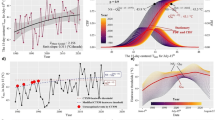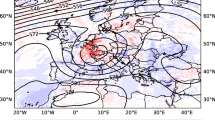Abstract
Parametric models are commonly used in frequency analysis of extreme hydrological events. To estimate extreme quantiles associated to high return periods, these models are not always appropriate. Therefore, estimators based on extreme value theory (EVT) are proposed in the literature. The Weissman estimator is one of the popular EVT-based semi-parametric estimators of extreme quantiles. In the present paper we propose a new family of EVT-based semi-parametric estimators of extreme quantiles. To built this new family of estimators, the basic idea consists in assigning the weights to the k observations being used. Numerical experiments on simulated data are performed and a case study is presented. Results show that the proposed estimators are smooth, stable, less sensitive, and less biased than Weissman estimator.









Similar content being viewed by others
References
Adamowski K, Liang G-C, Patry GG (1998) Annual maxima and partial duration flood series analysis by parametric and non-parametric methods. Hydrol Process 12(10–11):1685–1699
Adlouni SE, Bobée B, Ouarda T (2008) On the tails of extremeevent distributions in hydrology. J Hydrol NZ355(1–4):16–33
Apipattanavis S, Rajagopalan B, Lall U (2010) Local polynomial-based flood frequency estimator for mixed population. J Hydrol Eng 15(9):680–691
Balkema A, de Haan L (1974) Residual life time at a great age. Annals of Probab 2(5):792–804
Beirlant J, Broniatowski M, Teugels JL, Vynckier P (1995) The mean residual life function at great age: applications to tail estimation. J Stat Plan Inference 45(1-2):21–48
Beirlant J, Dierckx G, Guilllou A, Stărică C (2002) On exponential representations of log-spacings of extreme order statistics. Extremes 5(2):157–180
Beirlant J, Dierckx G, Guillou A (2005) Estimation of the extreme value index and regression on generalized quantile plots. Ann Stat 11(6):949–970
Beirlant J, Goegebeur Y, Teugels J, Segers J (2004) Statistics of extremes: theory and applications. Wiley Series in Probability and Statistics. Wiley, Chichester
Beirlant J, Teugels J, Vynckier P (1996a) Practical analysis of extreme values. Leuven University Press, Leuven
Beirlant J, Vynckier P, Teugels J (1996b) Excess functions and estimation of the extreme value index. Bernoulli 2(4):293–318
Bingham NH, Goldie CM, Teugels JL (1987) Regular variation, vol 27. Encyclopedia of mathematics and its applications. Cambridge University Press, Cambridge
Bobée B, Cavadias G, Ashkar F, Bernier J, Rasmussen P (1993) Towards a systematic approach to comparing distributions used in flood frequency analysis. J Hydrol NZ 142:121–136
Breiman L, Stone CJ, Kooperberg C (1990) Robust confidence bounds for extreme upper quantiles. J Stat Comput Simul 37(3–4):127–149
Brunet-Moret Y (1969) Étude de quelques lois statistiques utilisées en hydrologie. Cahiers d’hydrologie 6(3):3–100
Caeiro F, Gomes M (2006) A new class of estimators of a “scale” second order parameter. Extremes 9(3–4):193–211
Caeiro F, Gomes M, Rodrigues L (2009) Reduced-bias tail index estimators under a third-order framework. Commun Stat Theory Methods 38(7):1019–1040
Chebana F, Adlouni S, Bobée B (2010) Mixed estimation methods for halphen distributions with applications in extreme hydrologic events. Stoch Environ Res Risk Asses 24(3):359–376
Chen Y, Xu S, Sha Z, Pieter VG, Sheng-Hua G (2004) Study on L-moment estimations for log-normal distribution with historical flood data. Int Assoc Hydrol Sci 289:107–113
Coles S (2001) An introduction to statistical modeling of extreme values. Springer series in statistics, 1st ed. Springer, New York
Daouia A, Gardes L, Girard S, Lekina A (2011) Kernel estimators of extreme level curves. Test 20(2):311–333
de Haan L (1984) Slow variation and characterization of domains of attraction. In: Tiago de Oliveira J (ed) Statistical extremes and applications. Reidel, Dorchrecht, pp 31–48
de Haan L, Ferreira A (2006) Extreme value theory: an Introduction. Springer Series in Operations Research and Financial Engineering. Springer, New York
de Haan L, Peng L (1998) Comparison of tail index estimators. Stat Neerl 52(1):60–70
de Wet T, Goegebeur Y, Guillou A (2012) Weighted moment estimators for the second order scale parameter. Methodol Comput Appl Probab 14:753–783
Dekkers A, de Haan L (1989) On the estimation of the extreme value index and large quantile estimation. Ann Stat 17(4):1795–1832
Diebolt J, Gardes L, Girard S, Guillou A (2008) Bias-reduced extreme quantiles estimators of Weibull distributions. J Stat Plan Inference 138(5):1389–1401
Dierckx G, Beirlant J, Waal DD, Guillou A (2009) A new estimation method for Weibull-type tails based on the mean excess function. J Stat Plan Inference 139(6):1905–1920
Ditlevsen O (1994) Distribution arbitrariness in structural reliability. In: Schueller G, Shinozuka M (eds) 6th international conference on structural safety and reliability. Balkema, Rotterdam, pp 1241–1247
Drees H (1995) Refined Pickands estimator of the extreme value index. Ann Stat 23(6):2059–2080
Drees H, Kaufmann E (1998) Selecting the optimal sample fraction in univariate extreme value estimation. Stoch Process Appl 75(2):149–172
Embrechts P, Klüppelberg C, Mikosch, T (1997) Modelling extremal events for insurance and finance. Springer Verlag, New York
Falk M (1995) On testing the extreme value index via the Pot-method. Ann Stat 23(6):2013–2035
Feuerverger A, Hall P (1999) Estimating a tail exponent by modelling departure from a Pareto distribution. Ann Stat 27(2):760–781
Fisher R, Tippet L (1928) Limiting forms of the frequency distribution of the largest or smallest member of a sample. Proc Camb Philos Soc 24:180–190
Gardes L, Girard S, Lekina A (2010) Functional nonparametric estimation of conditional extreme quantiles. J Multivar Anal 101(2):419–433
Girard A, Guillou A, Stupfler G (2012) Estimating an endpoint with high order moments. Test 21:697–729
Gnedenko B (1943) Sur la distribution limite du terme maximum d’une série aléatoire. Ann Math 44(3):423–453
Goegebeur Y, Beirlant J, de Wet T (2010) Kernel estimators for the second order parameter in extreme value statistics. J Stat Plan Inference 140(9):2632–2652
Gomes MI, Oliveira O (2001) The bootstrap methodology in statistics of extremes: theory and applications–choice of the optimal sample fraction. Extremes 4(4):331–358
Guida M, Longo M (1988) Estimation of probability tails based on generalized extreme value distributions. Reliab Eng Syst Saf 20(3):219–242
Guillou A, Hall P (2001) A diagnostic for selecting the threshold in extreme value analysis. J R Stat Soc Ser B 63(2):293–305
Haddad K, Rahman A (2011) Selection of the best fit flood frequency distribution and parameter estimation procedure: a case study for Tasmania in Australia. Stoch Environ Res Risk Assess 25(3):415–428
Haeusler E, Teugels J (1985) On asymptotic normality of Hill’s estimator for the exponent of regular variation. Ann Stat 13(2):743–756
Hall P, Park BU (2002) New methods for bias correction at endpoints and boundaries. Ann Stat 30(5):1460–1479
Hill B (1975) A simple general approach to inference about the tail of a distribution. Ann Stat 3(5):1163–1174
Hosking JRM, Wallis JR (1987) Parameter and quantile estimation for the generalized Pareto distribution. Technometrics 29(3):339–1349
Hosking JRM, Wallis JR, Wood EF (1985) Estimation of the generalized extreme-value distribution by the method of probability-weighted comments. Technometrics 27(3):251–261
Kratz M, Resnick S (1996) The QQ-estimator and heavy tails. Stoch Model 12(4):699–724
Lall U, il Moon Y, Bosworth K (1993) Kernel flood frequency estimators: bandwidth selection and kernel choice. Water Resour Res 29(4):1003–1015
Lang M, Ouarda T, Bobée B (1999) Towards operational guidelines for over-threshold modeling. J Hydrol NZ 225(3–4):103–117
Lekina A (2010) Estimation non-paramétrique des quantiles extrêmes conditionnels. PhD thesis, Université de Grenoble
Li D, Peng L (2009) Does bias reduction with external estimator of second order parameter work for endpoint. J Stat Plan Inference 139(6):1937–1952
Moon Y-I, Lall U (1994) Kernel quantite function estimator for flood frequency analysis. Water Resour Res 30(11):3095–3103
Ouarda TB, Girard C, Cavadias GS, Bobée B (2001) Regional flood frequency estimation with canonical correlation analysis. J Hydrol NZ 254(1–4):157–173
Pickands J (1975) Statistical inference using extreme order statistics. Ann Stat 3(1):119–131
Prescott P, Walden AT (1980) Maximum likelihood estimation of the parameters of generalized extreme-value distribution. Biometrika 67(3):723–724
Quintela-del-Río A, Francisco-Fernández M (2011) Analysis of high level ozone concentrations using nonparametric methods. Sci Total Environ 409(6):1123–1133
Rényi A (1953) On the theory of order statistics. Acta Math Hung 4(3–4):191–231
Rosen O, Weissman I (1996) Comparison of estimation methods in extreme value theory. Commun Stat Theory Methods 24(4):759–773
Salvadori G, De Michele C, Kottegoda NT, Rosso R (2007) Extremes in nature: an approach using copulas. Springer, Dordrecht
Schultze J, Steinebach J (1996) On least squares estimates of an exponential tail coefficient. Stat Decis 14(3):353–372
Smith J (1987) Estimating the upper tail of flood frequency distributions. Water Resour Res 23(8):1657–1666
Smith RL (1985) Maximum likelihood estimation in a class of nonregular cases. Biometrika 72(1):67–92
Smith RL (1986) Extreme value theory based on the r largest annual events. J Hydrol NZ 86(1-2):27–43
Stedinger JR (2000) Flood frequency analysis and statistical estimation of flood risk. In: Wohl EE (ed) Inland flood hazards: human, riparian and aquatic communities. Cambridge University Press, Cambridge, pp 334–358
Tsourti Z, Panaretos J (2001) A simulation study on the performance of extreme-value index estimators and proposed robustifying modifications. In: 5th Hellenic European conference on computer mathematics and its applications, vol 2. Athens, Greece, pp 847–852
Weissman I (1978) Estimation of parameters and large quantiles based on the k-largest observations. J Am Stat Assoc 73(364):812–815
Willems P, Guillou A, Beirlant J (2007) Bias correction in hydrologic GPD based extreme value analysis by means of a slowly varying function. J Hydrol NZ 338(3–4):221–236
Young-Il M, Lall U, Bosworth K (1993) A comparison of tail probability estimators for flood frequency analysis. J Hydrol NZ 151(2-4):343–363
Yue S, Ouarda T, Bobée B, Legendre P, Bruneau P (1999) The Gumbel mixed model for flood frequency analysis. J Hydrol 226(1–2):88–100
Acknowledgments
Financial support for this study was graciously provided by the Natural Sciences and Engineering Research Council (NSERC) of Canada and the Canada Research Chair Program. The authors wish to express their appreciation to the reviewers and the Editor-in-Chef for their invaluable comments and suggestions.
Author information
Authors and Affiliations
Corresponding author
Rights and permissions
About this article
Cite this article
Lekina, A., Chebana, F. & Ouarda, T.B.M.J. Weighted estimate of extreme quantile: an application to the estimation of high flood return periods. Stoch Environ Res Risk Assess 28, 147–165 (2014). https://doi.org/10.1007/s00477-013-0705-2
Published:
Issue Date:
DOI: https://doi.org/10.1007/s00477-013-0705-2




